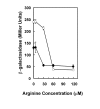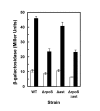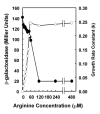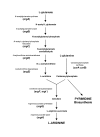Stationary phase expression of the arginine biosynthetic operon argCBH in Escherichia coli
- PMID: 16504055
- PMCID: PMC1413537
- DOI: 10.1186/1471-2180-6-14
Stationary phase expression of the arginine biosynthetic operon argCBH in Escherichia coli
Abstract
Background: Arginine biosynthesis in Escherichia coli is elevated in response to nutrient limitation, stress or arginine restriction. Though control of the pathway in response to arginine limitation is largely modulated by the ArgR repressor, other factors may be involved in increased stationary phase and stress expression.
Results: In this study, we report that expression of the argCBH operon is induced in stationary phase cultures and is reduced in strains possessing a mutation in rpoS, which encodes an alternative sigma factor. Using strains carrying defined argR, and rpoS mutations, we evaluated the relative contributions of these two regulators to the expression of argH using operon-lacZ fusions. While ArgR was the main factor responsible for modulating expression of argCBH, RpoS was also required for full expression of this biosynthetic operon at low arginine concentrations (below 60 microM L-arginine), a level at which growth of an arginine auxotroph was limited by arginine. When the argCBH operon was fully de-repressed (arginine limited), levels of expression were only one third of those observed in deltaargR mutants, indicating that the argCBH operon is partially repressed by ArgR even in the absence of arginine. In addition, argCBH expression was 30-fold higher in deltaargR mutants relative to levels found in wild type, fully-repressed strains, and this expression was independent of RpoS.
Conclusion: The results of this study indicate that both derepression and positive control by RpoS are required for full control of arginine biosynthesis in stationary phase cultures of E. coli.
Figures







Similar articles
-
The Escherichia coli SOS gene sbmC is regulated by H-NS and RpoS during the SOS induction and stationary growth phase.Biochem Biophys Res Commun. 2001 Nov 9;288(4):1052-8. doi: 10.1006/bbrc.2001.5872. Biochem Biophys Res Commun. 2001. PMID: 11689018
-
Enhanced expression of the bgl operon of Escherichia coli in the stationary phase.FEMS Microbiol Lett. 2008 Nov;288(1):131-9. doi: 10.1111/j.1574-6968.2008.01346.x. FEMS Microbiol Lett. 2008. PMID: 18793199
-
Effect of rpoS gene knockout on the metabolism of Escherichia coli during exponential growth phase and early stationary phase based on gene expressions, enzyme activities and intracellular metabolite concentrations.Biotechnol Bioeng. 2006 Jun 20;94(3):585-95. doi: 10.1002/bit.20858. Biotechnol Bioeng. 2006. PMID: 16511888
-
[Stationary phase in Escherichia coli].Rev Latinoam Microbiol. 2005 Jul-Dec;47(3-4):92-101. Rev Latinoam Microbiol. 2005. PMID: 17061534 Review. Spanish.
-
Environmental tuning of mutation rates.Environ Microbiol. 2006 Feb;8(2):193-9. doi: 10.1111/j.1462-2920.2005.00968.x. Environ Microbiol. 2006. PMID: 16423008 Review.
Cited by
-
Revealing differentially expressed proteins in two morphological forms of Spirulina platensis by proteomic analysis.Mol Biotechnol. 2007 Jun;36(2):123-30. doi: 10.1007/s12033-007-0013-5. Mol Biotechnol. 2007. PMID: 17914191
-
Identification of genes that confer sediment fitness to Desulfovibrio desulfuricans G20.Appl Environ Microbiol. 2007 Oct;73(19):6305-12. doi: 10.1128/AEM.00715-07. Epub 2007 Aug 17. Appl Environ Microbiol. 2007. PMID: 17704273 Free PMC article.
-
Global gene expression analysis of long-term stationary phase effects in E. coli K12 MG1655.PLoS One. 2014 May 23;9(5):e96701. doi: 10.1371/journal.pone.0096701. eCollection 2014. PLoS One. 2014. PMID: 24858919 Free PMC article.
-
Transcriptomic Response Analysis of Escherichia coli to Palladium Stress.Front Microbiol. 2021 Oct 8;12:741836. doi: 10.3389/fmicb.2021.741836. eCollection 2021. Front Microbiol. 2021. PMID: 34690987 Free PMC article.
-
Identification of virulence associated loci in the emerging broad host range plant pathogen Pseudomonas fuscovaginae.BMC Microbiol. 2014 Nov 14;14:274. doi: 10.1186/s12866-014-0274-7. BMC Microbiol. 2014. PMID: 25394860 Free PMC article.
References
Publication types
MeSH terms
Substances
LinkOut - more resources
Full Text Sources
Other Literature Sources
Molecular Biology Databases

